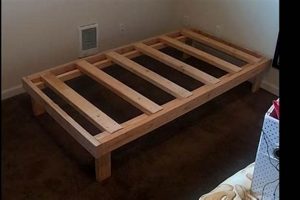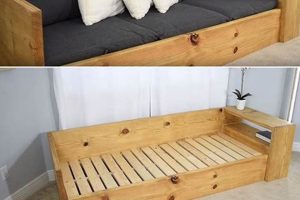A do-it-yourself weaving apparatus constructed from readily available materials allows for the creation of textiles and woven artwork. This self-made structure replicates the function of a traditional loom, enabling the interlacing of warp and weft threads to form fabric. As an example, a simple frame can be assembled using wood, nails or screws, and potentially cardboard, to serve as the foundation for weaving projects.
The construction of a personalized weaving device provides several advantages, including cost-effectiveness and customizability. Its utility lies in its accessibility, making the craft of weaving more approachable to beginners and allowing experienced weavers to tailor the size and dimensions to specific projects. Historically, similar rudimentary frame weaving techniques have been employed across cultures, illustrating a persistent human desire for textile creation regardless of resource limitations.
The subsequent sections will delve into the specific materials and construction techniques suitable for creating different types of frame weaving devices, explore various weaving patterns that can be achieved, and offer guidance on warping the structure to begin a weaving project.
Tips for Constructing a Frame Weaving Device
The creation of a frame weaving device requires careful consideration of materials and construction techniques to ensure a stable and functional platform for textile creation.
Tip 1: Material Selection is Paramount: The choice of material, typically wood, significantly impacts the device’s durability. Hardwoods offer superior stability and resistance to warping compared to softwoods. Proper curing of the wood is essential to minimize future deformation.
Tip 2: Accurate Measurements are Crucial: Precise measurements are necessary to ensure the warp threads are evenly spaced and under consistent tension. Inaccurate measurements can lead to irregularities in the woven fabric.
Tip 3: Secure Fastening Methods Enhance Stability: Utilizing screws and wood glue in conjunction, rather than relying solely on nails, provides a more robust and stable frame. Reinforce corners with metal brackets for added support, especially for larger frames.
Tip 4: Warp Spacing Considerations: The spacing of the warp threads determines the density of the woven fabric. Carefully plan the spacing based on the desired textile and the yarn weight to be used. Experiment with different spacing intervals to achieve varying textures.
Tip 5: Tensioning Mechanism Integration (Optional): For more advanced designs, consider incorporating a tensioning mechanism, such as adjustable bars, to control warp thread tension during the weaving process. This is particularly beneficial for larger or more complex projects.
Tip 6: Surface Finishing Prevents Snagging: Sanding all surfaces and edges thoroughly eliminates splinters and prevents the yarn from snagging during weaving. Apply a non-toxic sealant or varnish to protect the wood and further smooth the surface.
These considerations contribute to the creation of a durable and efficient frame weaving device, promoting a more enjoyable and successful weaving experience.
The following sections will explore advanced weaving techniques applicable to this type of frame and provide guidance on troubleshooting common weaving challenges.
1. Frame Material
The structural integrity and longevity of a self-constructed weaving apparatus are intrinsically linked to the frame material selection. This choice directly impacts the device’s ability to withstand warp tension, resist warping or deformation, and ultimately influence the quality of the woven textile. Inadequate material selection can lead to structural failure, inconsistent warp tension, and compromised weaving outcomes. For instance, using untreated softwood for a large frame intended for heavy yarns may result in bending or breaking under tension, rendering the device unusable.
Hardwoods, such as oak or maple, provide superior stability and resistance to deformation compared to softwoods like pine or fir. The increased density and rigidity of hardwoods allow for greater warp tension without compromising the frame’s structural integrity. Furthermore, appropriate material preparation, including proper seasoning and drying, is crucial to minimize warping and cracking over time. Reclaimed wood, while often cost-effective, necessitates careful inspection to ensure structural soundness and the absence of defects that could compromise the weaving process. The selection extends beyond wood. Metal frames, though less common for do-it-yourself projects, offer exceptional strength and stability, albeit at a potentially higher cost and requiring specialized tools for construction.
Therefore, understanding the properties of different materials and their suitability for varying weaving projects is essential for the successful construction and utilization of a personalized weaving device. Choosing an inappropriate material not only increases the risk of structural failure but also diminishes the potential for creating high-quality, durable textiles. Proper material selection is an investment in the long-term viability and performance of the weaving apparatus. Ignoring this critical aspect can negate the benefits of a self-constructed approach.
2. Warp Spacing
Warp spacing, the distance between individual warp threads on a weaving frame, directly influences the characteristics of the woven fabric. Its precise management is crucial when utilizing a self-constructed weaving apparatus, as it affects fabric density, drape, and structural integrity.
- Density and Texture
The proximity of warp threads determines the density of the weave. Closer spacing results in a denser, more compact fabric, while wider spacing creates a looser, more open weave. This impacts the texture and hand feel of the final product. For example, a tightly spaced warp is necessary for a durable tapestry, whereas a more open spacing can create a lightweight scarf. Inaccurate spacing on a self-made frame can lead to uneven density and an unprofessional appearance.
- Yarn Compatibility
The appropriate warp spacing depends heavily on the weight and thickness of the yarn being used for both warp and weft. Finer yarns require closer spacing to create a stable fabric, while thicker yarns necessitate wider spacing to avoid overcrowding. Attempting to use a bulky yarn on a tightly spaced warp will result in a difficult and potentially damaging weaving process. A self-constructed frame allows for customized spacing to accommodate a wide range of yarn types, but careful planning is essential.
- Edge Stability
Proper warp spacing is particularly critical at the edges of the weaving to prevent unraveling and maintain structural integrity. If the warp threads are too far apart at the edges, the weft threads may slip off, leading to a weak and unstable edge. Techniques such as selvedge weaving or the use of edge cords can mitigate this issue, but appropriate initial warp spacing remains fundamental. On a self-made frame, ensuring consistent spacing along the entire width is paramount to achieving durable edges.
- Pattern Definition
Warp spacing also influences the clarity and definition of woven patterns. In complex patterns, accurate and consistent spacing is essential for precise execution and visual clarity. Uneven spacing can distort the pattern and compromise its intended appearance. When creating patterned textiles on a self-built device, attention to warp spacing translates directly into pattern precision.
These aspects illustrate the critical relationship between warp spacing and successful weaving on a do-it-yourself frame. Careful consideration and precise execution of warp spacing are prerequisites for achieving desired fabric characteristics and ensuring the overall quality of the woven textile. The capacity to control this element is a key advantage when working with a weaving apparatus made for specific purposes.
3. Tension Control
Tension control represents a fundamental element in the successful operation of a self-constructed weaving apparatus. Inconsistent or inadequate warp tension directly precipitates a cascade of detrimental effects on the resulting textile. For instance, uneven tension can manifest as fabric distortions, variations in weave density, and difficulties in maintaining consistent selvedges. The absence of effective tension management strategies on a device made at home can lead to significant material waste, increased labor expenditure, and ultimately, the production of textiles of unacceptable quality. Therefore, understanding and implementing proper tensioning techniques are not merely advisable but critical for achieving desirable weaving outcomes.
Various approaches facilitate adequate tension control on a personalized weaving frame. A simple method involves manually adjusting the warp threads at the commencement of the weaving process, aiming for uniform tautness across the entire warp. However, this technique offers limited control during the weaving process and requires frequent readjustments. More sophisticated devices incorporate mechanical tensioning systems, such as ratchets or adjustable bars, which allow for dynamic tension adjustments as weaving progresses. Examples include adding a simple turnbuckle-style system to the frame ends, enabling incremental tension increases as the warp is consumed. The chosen method should be determined based on the frame’s design, the materials being used, and the complexity of the weaving project.
In summary, tension control is an indispensable aspect of utilizing a self-built weaving frame. The consequences of neglecting this element can range from minor imperfections to complete project failure. Implementing an effective tensioning system, whether through manual adjustments or mechanical mechanisms, ensures consistent warp tension, resulting in higher quality textiles. Mastery of tension control is thus integral to realizing the full potential of weaving using a frame made at home.
4. Size Customization
The adaptability of a self-constructed weaving apparatus is significantly enhanced by the potential for size customization. This feature allows the tailoring of the device’s dimensions to accommodate specific project requirements, thereby expanding the scope of possible textile creations.
- Project-Specific Adaptation
The ability to modify dimensions enables the creation of frames perfectly suited to specific weaving projects, such as narrow scarves or large wall hangings. This contrasts with commercially available looms, which may impose size limitations. For instance, a tapestry artist might require an unusually large frame, easily achieved through self-construction and dimensionally tailored to the artwork’s design. A small frame can be constructed specifically for weaving samples or creating small embellishments.
- Material Efficiency
Precise size control minimizes material waste by allowing the construction of a frame that closely matches the intended dimensions of the woven textile. This contrasts with using a standard-sized frame for a smaller project, which can result in unused warp threads and inefficient material utilization. Using recycled material will result in a sustainable loom with no waste.
- Storage Considerations
Customizable size allows for the creation of a frame that fits within available storage space. This is particularly relevant in situations with limited room, where a standard-sized loom might be impractical. A collapsible frame can be made to minimize storage requirements.
- Weaving Technique Integration
Certain weaving techniques are more effectively executed on frames of specific sizes. For example, complex tapestry techniques might necessitate a larger frame to accommodate the design, while inkle weaving is typically performed on a narrower, longer frame. Adjusting the size is perfect for this task.
These facets highlight the instrumental role of size customization in optimizing the functionality and versatility of a self-constructed weaving apparatus. The ability to tailor dimensions to specific project needs contributes to material efficiency, storage practicality, and the effective execution of diverse weaving techniques. This level of adaptability sets a do-it-yourself frame apart, allowing the tailor to fit the tool to the job.
5. Joint Stability
Joint stability is paramount in the construction of a self-made weaving frame. The integrity of the woven textile depends directly on the structural soundness of the frame, particularly at its joints. Failure in these areas can lead to uneven warp tension, frame distortion, and ultimately, a compromised weaving process.
- Load Distribution and Frame Integrity
The joints of a frame bear the cumulative load of warp tension. Inadequate joint construction leads to stress concentration at these points, increasing the risk of failure. A well-designed joint distributes this tension evenly across the frame, maintaining dimensional stability. For example, a mitered and glued corner joint reinforced with screws is significantly stronger than a simple butt joint held together with nails. The selection of appropriate joint construction methods is, therefore, integral to the overall frame integrity.
- Material Compatibility and Adhesive Selection
The choice of adhesive and fastening methods must align with the materials used to construct the frame. Using the wrong adhesive can result in a weak bond that fails under sustained tension. Similarly, fasteners must be of sufficient size and strength to withstand the applied load. When working with hardwoods, a high-quality wood glue designed for structural applications is recommended. For metal frames, welding or robust bolting methods are essential. Incompatible materials and joining techniques compromise long-term stability.
- Dimensional Accuracy and Joint Fit
Precise cutting and assembly are critical for achieving tight-fitting joints. Gaps or misalignments create weak points that are prone to failure. Ensuring that all pieces are cut to the correct dimensions and that joints are properly aligned during assembly minimizes stress and maximizes strength. Clamping during adhesive curing is essential for maintaining alignment and ensuring a strong bond. A poorly fitted joint compromises the entire structure.
- Long-Term Durability and Environmental Factors
Joint stability must account for the long-term effects of environmental factors, such as humidity and temperature fluctuations, which can cause materials to expand or contract. These changes can stress joints, leading to weakening or failure over time. Selecting materials and construction methods that are resistant to environmental degradation is important for ensuring long-term durability. Protective coatings or sealants can further mitigate the effects of moisture and temperature changes.
The preceding points underscore the critical relationship between joint stability and the overall effectiveness of a self-constructed weaving frame. Robust joint construction, appropriate material selection, dimensional accuracy, and consideration of environmental factors are all essential for ensuring a stable and reliable weaving platform. Neglecting these aspects undermines the structural integrity of the device and compromises the quality of the woven textiles it produces.
6. Cost Efficiency
The construction of a do-it-yourself weaving apparatus presents a fiscally prudent alternative to purchasing commercially manufactured looms. This approach offers substantial savings by leveraging readily available materials and minimizing reliance on specialized equipment. Cost-effectiveness is a primary driver for individuals and institutions seeking to engage in weaving without incurring significant capital expenditure.
- Material Sourcing and Repurposing
The acquisition of materials for a self-built frame weaving device typically involves sourcing inexpensive or repurposed items. Wood, nails, and screws constitute the primary components, often obtainable from local hardware stores or salvaged from discarded furniture. This contrasts with the cost of specialized loom parts, which can be prohibitively expensive. For instance, a simple frame can be constructed from reclaimed lumber, significantly reducing material costs compared to purchasing a new loom. The cost efficiency extends to yarn, as inexpensive and recycled options are available for learning and experimentation.
- Labor and Skill Investment
While self-construction requires an investment of time and effort, it eliminates the direct financial outlay associated with purchasing a pre-assembled loom. The labor involved is an investment in skill development, as the builder gains practical experience in woodworking and design. This contrasts with the passive consumption of a manufactured product. The skills acquired during construction can be further leveraged to create additional weaving tools or adapt the frame to evolving project needs. Building a loom promotes self-sufficiency and resourcefulness.
- Customization and Scalability
Self-construction allows for precise tailoring of the frame to specific project requirements, preventing the need to purchase multiple looms of varying sizes. This scalability minimizes unnecessary expenditure and maximizes resource utilization. A large frame can be constructed for tapestry weaving, while a smaller frame can be built for creating samples or embellishments. This adaptability is not always achievable with commercially available looms, which often come in fixed sizes and configurations. The capacity to adapt and scale the apparatus reduces the cost of undertaking diverse weaving projects.
- Maintenance and Repair
A do-it-yourself frame weaving device offers the advantage of simplified maintenance and repair. Components are readily replaceable, and repairs can be performed using basic tools and readily available materials. This contrasts with the potential for costly repairs to complex commercial looms, which may require specialized technicians and proprietary parts. The simplicity of a self-built frame ensures ease of maintenance and minimizes long-term operational costs. Inexpensive tools and basic understanding make all the difference.
The foregoing aspects illustrate the economic advantages of constructing a weaving apparatus. By leveraging inexpensive materials, investing in skill development, and prioritizing adaptability and ease of maintenance, individuals and institutions can significantly reduce the cost of engaging in the art of weaving. The self-constructed frame represents a fiscally responsible and empowering alternative to commercial products, promoting accessibility and resourcefulness.
Frequently Asked Questions
The following section addresses common inquiries and concerns regarding the construction and utilization of self-made weaving frames, providing clear and concise answers to assist in informed decision-making.
Question 1: What is the minimum size requirement for a functional weaving frame?
The minimum size of a functional weaving frame is dictated by the intended project dimensions and the desired level of complexity. A frame smaller than 12 inches by 12 inches may prove limiting for larger projects or intricate patterns, though suitable for small samples or narrow bands. Consider the final product dimensions when determining minimal frame size.
Question 2: What type of wood is best suited for frame construction?
Hardwoods such as oak, maple, or birch offer superior structural stability and resistance to warping compared to softwoods. However, properly seasoned and treated softwoods can be utilized for smaller frames or less demanding projects. The selection depends on the anticipated load and long-term durability requirements.
Question 3: How is consistent warp tension achieved on a self-made frame?
Consistent warp tension can be achieved through careful warping techniques, even spacing of warp threads, and the use of a tensioning mechanism if desired. Manual adjustment and periodic tightening may be necessary. The frame’s structural integrity is also crucial for maintaining consistent tension.
Question 4: What tools are essential for constructing a frame weaving device?
Essential tools include a measuring tape, saw (hand saw or power saw), drill, screwdriver, hammer, and clamps. A wood square and sandpaper are also recommended for ensuring accuracy and smooth surfaces. The specific tools required may vary depending on the chosen construction method.
Question 5: How can warping be simplified on a large frame?
Warping can be simplified by utilizing a warping board or peg system to pre-measure and organize the warp threads. A consistent warping pattern and careful attention to tension are also important. Dividing the warp into smaller sections can make the process more manageable.
Question 6: What are common pitfalls to avoid during frame construction?
Common pitfalls include inaccurate measurements, poorly constructed joints, inadequate material selection, and insufficient attention to warp tension. Careful planning, precise execution, and thorough inspection are essential for avoiding these issues.
Proper planning and execution are paramount to the successful construction and utilization of a frame weaving device. Addressing potential challenges proactively ensures a more rewarding and productive weaving experience.
The following section will delve into advanced weaving techniques that can be applied to a self-built frame, further expanding the possibilities of this versatile tool.
Conclusion
The preceding examination of the diy loom frame has elucidated its fundamental characteristics, construction considerations, and operational nuances. Emphasis has been placed on the interdependence of material selection, joint stability, warp spacing, and tension control in achieving desired textile outcomes. Size customization and cost efficiency have been presented as compelling advantages of this self-reliant approach to weaving.
The information presented serves as a foundation for informed engagement with the art of weaving. Continued exploration of weaving techniques, material properties, and innovative frame designs will undoubtedly expand the creative potential of this craft. The sustained pursuit of knowledge and skillful execution remains essential for realizing the full potential of the diy loom frame and contributing to the rich tapestry of textile arts.







